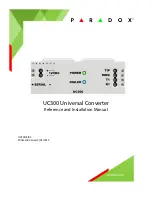
1. Conditions of safe operation
1.3. Operation list
The operations applied at installation and the first start-up of the drive
1
After unpacking the converter, it is necessary to check up visually the presence of damages which could arise during
transport.
2
Check up the correspondence between the delivered frequency converter and the order - check up the ratings plate on the
case. Delivery includes:
•
the frequency converter with the User Manual,
•
a choke – if it was ordered, recommended for rated power 5.5 kW and above,
•
a ferrite ring or RFI filter - depending on the order.
3
Check up the correspondence between the conditions in which the converter will be used and conditions of an environment
for which it is designed (section 1.4).
4
Installation of the frequency converter should be made due to the principles of safety and EMC rules, listed in section 2.
5
Perform the configuration of the converter in accordance with the chapters of this manual.
1.4. Environmental conditions
Degree of pollution
The second degree of pollution has been assumed during the design, at which there are normally only non-
conducting pollution. However, there is a probability of temporary conductivity caused by a condensation, when the
converter is disconnected from the voltage source.
In case the environment in which the frequency converter will work contains pollution, which can influence its
safety, it is necessary to apply appropriate counteraction, using, for example, additional cases, air channels, filters etc.
Climatic conditions
Installation site
During warehousing
During transport
Temperature
from -10°C to +55°C
from -25°C to +55°C
from -25°C to +70°C
Protective packing
Relative humidity
from 5% to 95%
from 5% to 95%
Max 95%
Short-term, insignificant condensation on the external side of the converter case is permitted only
when the converter is disconnected from the voltage source.
Air pressure
from 86 kPа to 106 kPа
from 86 kPa to 106 kPa
from 70 kPa tо 106 kPa
1.5. Recycle
Equipment containing electrical and electronic components can not be removed into municipal
waste containers. Such equipment must be separated from other wastes and attached to electrical and
electronic waste in accordance with applicable local regulations.
This way you help to prevent uncontrolled waste disposal and promote the recycling of materials.
1.6. Limits of responsibility
Despite all the efforts and due diligence of TWERD Power Electronics does not guarantee that the published
data is error-free.
The User is obliged to read the information contained in this Manual before using the device. The TWERD Power
Electronics Company is not responsible for any consequences of incorrect use of information contained in this Manual
or any infringement of patents or other rights of third parties that may arise from their use.
TWERD Power Electronics products are not authorized for use as critical components in life support devices or
systems without the written consent of TWERD Power Electronics. Furthermore, TWERD Power Electronics are not
responsible for any damages resulting from the use of converters outside its intended purpose.
The information contained in this manual is subject to change without notice, and it supersedes and supplements
the information previously provided.
TWERD logo is a trademark of TWERD Power Electronics. All trademarks used are the property of their
respective owners.
For more information contact out technical support at: [email protected]
1) For nominal load temperature 40
o
C was assumed; however, for lower loads higher temperatures are acceptable.
Frequency converter MFC710 type with OP-11 control panel. TWERD Power Electronics
13














































